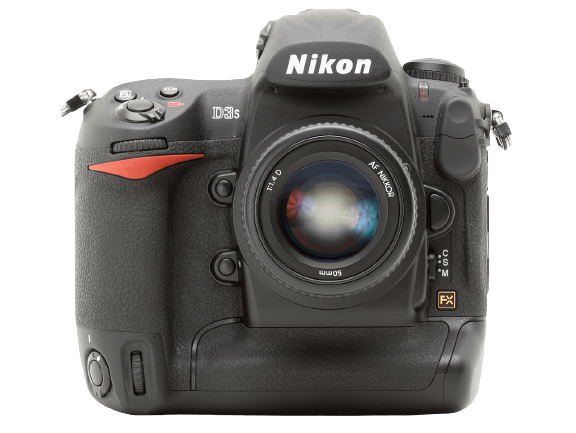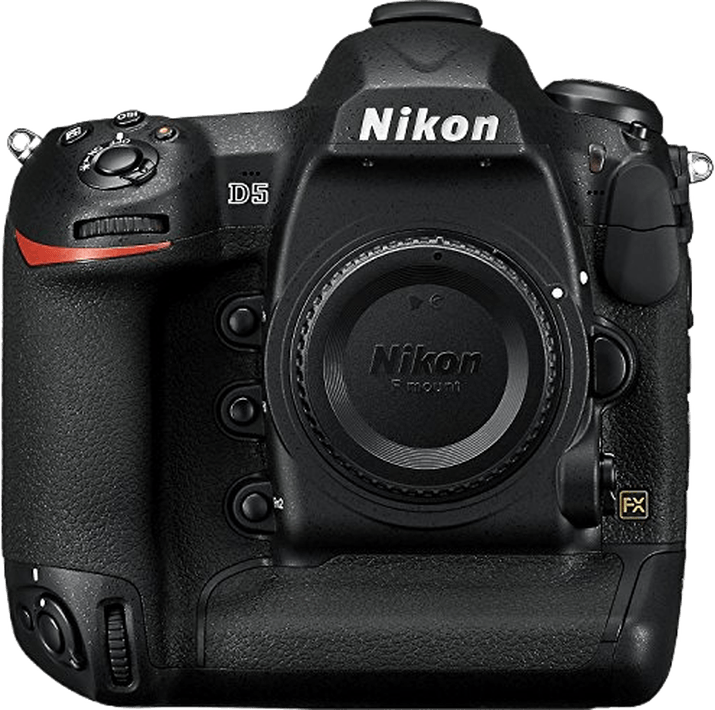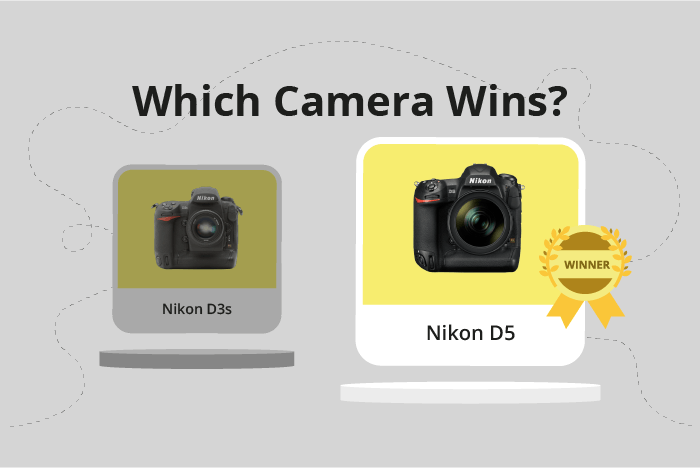Nikon D3s vs D5 Comparison
Nikon D3s

Nikon D5

The Nikon D5 outperforms the Nikon D3s with a score of 74/100 compared to the D3s’s 57/100. Both cameras are DSLRs and have similar sizes, with the D5 being slightly larger and heavier. They also share a common launch price difference, with the D5 priced at $6,500 and the D3s at $5,510.
The Nikon D5 excels with its higher score, which is due to its better specifications and overall performance. On the other hand, the Nikon D3s has its advantages, such as being lighter in weight, making it easier to carry around for extended periods.
Taking all factors into consideration, the Nikon D5 is the superior camera, offering higher quality and performance. However, the Nikon D3s remains a viable option for those seeking a lighter camera at a lower price point.
Nikon D3s vs D5 Overview and Optics
The Nikon D5 emerges as the winner in optics with a score of 72 out of 100, compared to the Nikon D3s, which scored 55. Both cameras share some common specifications, such as the CMOS sensor type, full-frame sensor size, Nikon F FX lens mount, and the absence of image stabilization.
The Nikon D5 outperforms the D3s in several aspects. It has a higher megapixel count of 20.8 compared to 12.1 in the D3s, which results in sharper and more detailed images. The D5 also has a faster shooting speed of 12 frames per second, as opposed to the D3s’s 11 frames per second, allowing for better continuous shooting performance. Furthermore, the D5 boasts an Expeed 5 processor, while the D3s has an older Expeed processor, which contributes to the D5’s improved image processing capabilities. Lastly, the D5 has a higher DXOMARK sensor score of 88, compared to the D3s’s score of 82, indicating better overall sensor performance.
Despite the overall higher score, the D3s does not have any specific advantages over the D5 in terms of optics. The D5 simply outperforms the D3s in all the key optical specifications.
Taking all these factors into account, it is clear that the Nikon D5 is the superior camera in terms of optics. Its higher megapixel count, faster shooting speed, more advanced processor, and better sensor performance make it a better choice for photographers seeking optimal image quality and performance. The Nikon D3s, though a capable camera, falls short when compared to the D5’s optical capabilities.
Nikon D3s vs D5 Video Performance
When it comes to video capabilities, the Nikon D3s does not offer any video functionality. This lack of video capabilities sets it apart from the Nikon D5, which does provide video features.
The Nikon D5 has a video score of 70 out of 100, making it a capable option for those interested in capturing video. The camera has a maximum video resolution of 4K, with dimensions of 3840 x 2160 pixels. This high resolution allows for clear and detailed footage. The maximum video frame rate for the Nikon D5 is 30 frames per second (fps), providing smooth motion in the captured video. An additional feature of the Nikon D5 is its built-in time-lapse functionality, which enables users to create stunning time-lapse videos with ease.
Taking into account the video capabilities, the Nikon D5 stands out as the better choice for those who require video functionality in their camera. While the Nikon D3s lacks video features, the Nikon D5 offers a range of options, including 4K resolution, 30fps frame rate, and built-in time-lapse functionality. This makes the Nikon D5 a more versatile camera for users who need both high-quality photography and video capabilities.
Nikon D3s vs D5 Features and Benefits
The Nikon D5 outperforms the Nikon D3s in features, scoring 74/100 compared to the D3s’s 54/100. Both cameras share some specifications, such as a screen size of 3 inches for the D3s and 3.2 inches for the D5, and neither has a flip screen or GPS. However, the D5 surpasses the D3s in several aspects, making it the superior choice for photographers looking for advanced features.
The D5 offers a significantly higher screen resolution, with 2,359,000 dots compared to the D3s’s 921,000 dots. This results in a sharper and clearer display, which can be essential for reviewing images and ensuring accurate focus. Additionally, the D5 has a touchscreen, allowing for quicker and more intuitive navigation through menus and settings. The D3s lacks this feature, requiring users to rely on buttons and dials for adjustments.
Another advantage of the D5 is its connectivity. The camera includes built-in Wi-Fi, enabling wireless image transfer and remote control through a smartphone or tablet. This can be particularly useful for sharing images quickly or shooting in challenging environments. Unfortunately, the D3s does not offer Wi-Fi or Bluetooth capabilities, limiting its versatility in this regard.
While the D3s falls short in these areas, it is still a reliable and capable camera. It may be suitable for photographers who prioritize simplicity and do not require advanced features or connectivity options.
Taking these points into consideration, it is clear that the Nikon D5 is the better choice for photographers seeking advanced features and connectivity. The D3s, while still a solid option, does not compete with the D5’s range of capabilities.
Nikon D3s vs D5 Storage and Battery
The Nikon D3s and Nikon D5 both score 87/100 for storage and battery, showcasing their similar performance in this aspect. Both cameras have two memory card slots and do not support USB charging. They differ in the types of memory cards accepted, with the D3s taking CompactFlash (Type I) and UDMA cards, while the D5 accepts Compact Flash and XQD cards.
The D3s outperforms the D5 in battery life, providing 4200 shots per charge with its EN-EL4a battery compared to the D5’s 3780 shots using the EN-EL18a battery. This longer battery life makes the D3s more suitable for extended shooting sessions.
On the other hand, the D5’s compatibility with both Compact Flash and XQD cards offers more flexibility in storage options, catering to different user preferences and potentially faster data transfer speeds with XQD cards.
Both cameras excel in storage and battery performance, with the D3s having an edge in battery life and the D5 providing more versatile storage options. The choice depends on the user’s priorities and requirements.
Nikon D3s vs D5 – Our Verdict
Are you still undecided about which camera is right for you? Have a look at these popular comparisons that feature the Nikon D3s or the Nikon D5:

